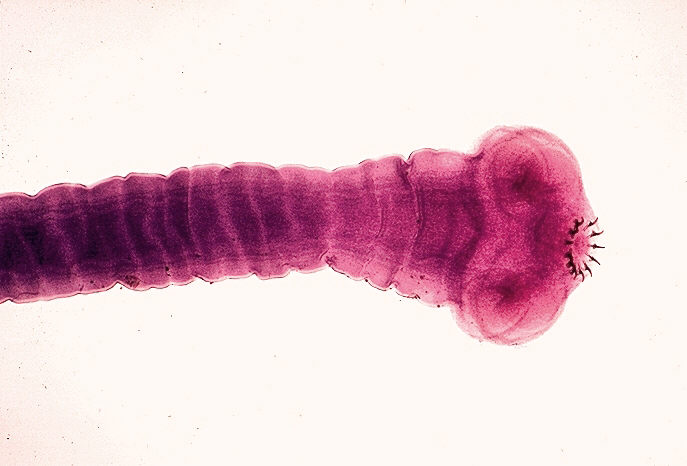Cestoda
| style="background:#Template:Taxobox colour;"|Cestoda | ||||||||||||
|---|---|---|---|---|---|---|---|---|---|---|---|---|
 Scolex of Taenia solium
| ||||||||||||
| style="background:#Template:Taxobox colour;" | Scientific classification | ||||||||||||
| ||||||||||||
| Orders | ||||||||||||
|
Subclass Cestodaria |
Editor-In-Chief: C. Michael Gibson, M.S., M.D. [1]
|
WikiDoc Resources for Cestoda |
|
Articles |
|---|
|
Most recent articles on Cestoda |
|
Media |
|
Evidence Based Medicine |
|
Clinical Trials |
|
Ongoing Trials on Cestoda at Clinical Trials.gov Clinical Trials on Cestoda at Google
|
|
Guidelines / Policies / Govt |
|
US National Guidelines Clearinghouse on Cestoda
|
|
Books |
|
News |
|
Commentary |
|
Definitions |
|
Patient Resources / Community |
|
Directions to Hospitals Treating Cestoda Risk calculators and risk factors for Cestoda
|
|
Healthcare Provider Resources |
|
Causes & Risk Factors for Cestoda |
|
Continuing Medical Education (CME) |
|
International |
|
|
|
Business |
|
Experimental / Informatics |
Cestoda is the class of parasitic flatworms, commonly called tapeworms, that live in the digestive tract of vertebrates as adults and often in the bodies of various animals as juveniles.
Overview
Authors Craig and Ito, in Intestinal Cestodes describe the gut-dwelling worm as a segmented, band like (Cestoda) in its adult stage (Craig & Ito 2007:524). What occurs in tissues and organs of vertebrates or humans, is the growth of a cyst-like juvenile or metacestode stage. The potential cause of illnesses and diseases is due to the metacestode stages happening in human tissues rather than the adult tapeworm (Craig and Ito 2007:524).
The tegument is the body surface of the adult tapeworm and due to this the tapeworms take the host nutrients and not attack the mucosa of the small intestine, or remove blood, hence infections are instead benevolent and most often don't show any signs of illness (Craig & Ito 2007:524). A carrier can notice the segments (proglottides) when using the bathroom for instance in the feces in a toilet bowl, around a latrine or frequently because the tapeworms are moving around constantly one may find it in the under-garments (Craig and Ito 2007: 524).
Life cycle
The life cycle of a tape worm starts out with an animal eating undercooked, infected meat. The tape worm will then grow, and release small packages with fertilized eggs and sperm. These packages are excreted out of the body. If they happen to, for example, get on grass, the package will open and by that time, the tape worm eggs will have developed. The eggs are released on to the grass, if a cow eats that grass, the eggs will become larva and burrow into the cow's muscle. And if that cow would be turned into meat and if any of that meat is undercooked, the whole cycle starts again.
Scolex
The Scolex or "head" of the worm attaches to the intestine of the definitive host. In some groups, the scolex is dominated by bothria, which are sometimes called "sucking grooves", and function like suction cups. Other groups have hooks and suckers that aid in attachment. Cyclophyllid cestodes can be identified by the presence of four suckers on their scolex, though they may have other structures.
While the scolex is often the most distinctive part of an adult tapeworm, it is often unnoticed in a clinical setting as it is inside the patient. Thus, identifying eggs and proglottids in feces is important.
Muscular system
The main nerve center of cestode is in scolex, motor and sensory innervation depends on number and complexity of scolex. Smaller nerves emanate from the commissures to supply the general body muscular and sensory ending.1 The cirrus and vagina are innervated and sensory endings around the genital pore are more plentiful than other areas. Sensory function includes both tactoreception and chemoreception.1
Proglottids
The body is composed of successive units posterior to the scolex, the proglottids. The sum of the proglottids is called a strobila, which is thin, resembling a strip of tape, and is the source of the common name tapeworm. Like some other flatworms, cestodes use flame cells (protonephridia) for excretion, which are located in the proglottids.
Mature or gravid proglottids are released from the mature tapeworm and leave the host in its feces.
Because each proglottid contains the male and female reproductive structures, they can reproduce independently. It has been suggested by some biologists that each should be considered a single organism, and that the tapeworm is actually a colony of proglottids.
Pathology
According to Intestinal Cestodes, authors Craig, and Ito 2007 suggest that the effects of this gut dwelling Cestodes are usually very minimal. The people that have been infected by this tapeworm have described the following symptoms: abdominal discomfort and pain, cramp, colic, flatulence, diarrhea, constipation, nausea, dizziness, vomiting, restlessness, vertigo, headache, tiredness, malabsorption, anorexia, muscular pain, vitamin deficiency, megaloblastic anemia, weight loss (or gain), intestinal blockage, jejunal perforation, appendicitis, pancreatitis, pseudo-incontinence, pruritis ani, rectal-flutters, spontaneous voiding of segments from the anus, depression and psychosis (Craig & Ito 2007:524). Furthermore, through self-infection of Taenia Solium (the pork tapeworm) there has been in the past a serious life threatening infections of taeniais (also referred to as taeniosis) which may make the chances of neurocysticercosis go higher (Craig & Ito 2007: 524).
See also
- Diphyllobothrium (Fish tapeworm)
- Cysticercosis
- List of parasites (human)
References
- Campbell, Reece, and Mitchell, Biology, 1999
- Merck Manual of Medication Information, Second Home Edition, Online Version, Tapeworm Infection 2005
- Mayo Clinic Website on infectious diseases, Mayo Clinic - Tapeworm Infection, 2006
- Medline Plus - Taeniasis (tapeworm infection)
- University of South Carolina - School of Medicine - CESTODES (TAPE WORMS)
- Template:CDC
- Craig,Philip & Ito, Akira (2007). "Intestinal Cestodes". Current Opinion in Infectious Diseases 20: 524-532.
External links
- How Disgusting are Tapeworms? Article from TalktotheVet.com
cs:Tasemnice
de:Bandwürmer
et:Paelussid
hr:Trakavice
it:Cestoda
ka:თასმისებური ჭიები
la:Cestoda
lv:Lenteņi
lt:Kaspinuočiai
hu:Galandférgek
nl:Lintwormen
no:Bendelormer
qu:Unkaka
simple:Tapeworm
sk:Pásomnice (Cestodes)
sl:Trakulje
sr:Пантљичара
su:Cacing pita
sv:Bandmaskar
te:బద్దెపురుగు
uk:Стрічковий хробак